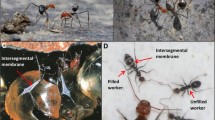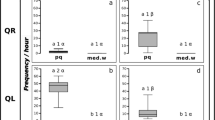Abstract
The question of the occurrence of nepotism in insect societies is central to inclusive fitness theory. Here we investigated the existence of nepotism in the facultative polygynous ant Ectatomma tuberculatum because various characteristics of this species may have favored the evolution of nepotistic behavior toward queens. We thus studied worker–queen care toward their mother queen vs. an unrelated unfamiliar queen, to determine if workers cared preferentially for their mother. Although we tried to facilitate the expression of nepotistic behaviors, we did not detect significant nepotism confirming the general trend of an absence of nepotism in social insects. We discuss about the specific causes that can explain the absence of nepotism in E. tuberculatum regarding the particular social organization of this species and its ecological dominance in the mosaic of arboreal ants.


Similar content being viewed by others
References
Ayasse M, Marlovits T, Tengö T, Taghizadeh T, Francke W (1995) Are there pheromonal dominance signals in the bumblebee Bombus hypnorum L (Hymenoptera, Apidae). Apidologie 26:163–180
Blatrix R, Jaisson P (2002) Absence of kin discrimination in a ponerine ant. Anim Behav 64:261–268
Blatrix R, Durand JL, Jaisson P (2000) Task allocation depends on matriline in the ponerine ant Gnamptogenys striatula Mayr. J Insect Behav 13:553–562
Bonavita-Cougourdan A, Clément JL, Lange C (1987) Nestmate recognition: the role of cuticular hydrocarbons in the ant Camponotus vagus Scop. J Entomol Sci 22:1–10
Bonavita-Cougourdan A, Theraulaz G, Bagneres AG, Roux M, Pratte M, Provost E, Clement JL (1991) Cuticular hydrocarbons, social organisation and ovarian development in a polistine wasp: Polistes dominulus christ. Comp Biochem Physiol B Comp Biochem Mol Biol 100:667–680
Boomsma JJ, Nielsen J, Sundström L, Oldham NJ, Tentschert J, Petersen HC, Morgan ED (2003) Informational constraints on optimal sex allocation in ants. Proc Natl Acad Sci USA 100:8799–8804
Breed MD, Robinson GE, Page RE (1990) Division of labour during honey bee colony defense. Behav Ecol Sociobiol 27:395–401
Breed MD, Welch CK, Cruz R (1994) Kin discrimination within honey bee (Apis mellifera) colonies: an analysis of the evidence. Behav Processes 33:25–39
Carlin NF (1989) Discrimination between and within colonies of social insects: Two null hypotheses. Neth J Zool 39:86–100
Carlin NF, Reeve HK, Cover SP (1993) Kin discrimination and division of labour among matrilines in the polygynous carpenter ant, Camponotus planatus. In: Keller L (ed) Queen number and sociality in insects. Oxford University Press, New York, pp 362–401
Châline N, Arnold G, Papin C, Ratnieks FLW (2003) Patriline differences in emergency queen rearing in the honey bee, Apis mellifera. Insectes Soc 50:234–236
Châline N, Martin SJ, Ratnieks FLW (2005) Absence of nepotism toward imprisoned young queens during swarming in the honey bee. Behav Ecol 16:403–409
Cuvillier-Hot V, Cobb M, Malosse C, Peeters C (2001) Sex, age and ovarian activity affect cuticular hydrocarbons in Diacamma ceylonense, a queenless ant. J Insect Physiol 47:485–493
D’Ettorre P, Heinze J (2005) Individual recognition in ant queens. Curr Biol 15:2170–2174
D’Ettorre P, Heinze J, Schulz C, Francke W, Ayasse M (2004) Does she smell like a queen? Chemoreception of a cuticular hydrocarbon signal in the ant Pachycondyla inversa. J Exp Biol 207:1085–1091
Dani FR, Foster KR, Zacchi F, Seppä P, Massolo A, Carelli A, Arévalo L, Queller D, Strassmann JE, Turillazzi S (2004) Can cuticular lipids provide sufficient information for within-colony nepotism in wasps. Proc R Soc Lond B 271:745–753
DeHeer CJ, Ross KG (1997) Lack of detectable nepotism in multiple-queen colonies of the fire ant Solenopsis invicta (Hymenoptera: Formicidae). Behav Ecol Sociobiol 40:27–33
Gilley DC (2003) Absence of nepotism in the harassment of duelling queens by honeybee workers. Proc R Soc Lond B 270:2045–2049
Good PI (2000) Permutation tests: a practical guide to resampling methods for testing hypotheses. Springer, New York
Gordon DM (1989) Ants distinguish neighbors from strangers. Oecologia 81:198–200
Grafen A (1990) Do animals really recognize kin. Anim Behav 39:42–54
Hamilton WD (1964) The genetical evolution of social behaviour, I, II. J Theor Biol 7:1–52
Hannonen M, Sundström L (2003) Worker nepotism among polygynous ants. Nature 421:910
Heinze J, Elsishans C, Hölldobler B (1997) No evidence for kin assortment during colony propagation in a polygynous ant. Naturwissenschaften 84:249–250
Hepper PG (1991) Kin recognition. Cambridge University Press, Cambridge
Holzer B, Kümmerli R, Keller L, Chapuisat M (2006) Sham nepotism as a result of intrinsic differences in brood viability in ants. Proc R Soc Lond B 273:2049–2052
Hora RR, Vilela E, Fénéron R, Pezon A, Fresneau D, Delabie J (2005) Facultative polygyny in Ectatomma tuberculatum (Formicidae, Ectatomminae). Insectes Soc 52:194–200
Isingrini M, Lenoir A, Jaisson P (1985) Preimaginal learning as a basis of colony-brood recognition in the ant Cataglyphis cursor. Proc Natl Acad Sci USA 82:8545–8547
Jaisson P (1973) L’imprégnation dans l’ontogenèse du comportement de soins aux cocons chez les formicines. In Proceedings of the 7th International Congress of the IUSSI, London, United Kingdom, pp 176–181
Jaisson P (1980) Les colonies mixtes plurispécifiques: un modèle pour l’étude des fourmis. Biologie-Ecologie Méditerranéenne 7:163–166
Keller L (1997) Indiscriminate altruism: unduly nice parents and siblings. Trends Ecol Evol 12:99–103
Keller L, Passera L (1993) Incest avoidance, fluctuating asymmetry, and the consequences of inbreeding in Iridomyrmex humilis, an ant with multiple queen colonies. Behav Ecol Sociobiol 33:191–199
Kirchner WH, Arnold G (2001) Intracolonial kin discrimination in honeybees: do bees dance with their supersisters. Anim Behav 61:597–600
Lahav S, Soroker V, Hefetz A, Vander Meer RK (1999) Direct behavioral evidence for hydrocarbons as ant recognition discriminators. Naturwissenschaften 86:246–249
Lehner PN (1996) Handbook of ethological methods. Cambridge University Press, Cambridge, England
Liebig J, Peeters C, Oldham NJ, Markstadter C, Hölldobler B (2000) Are variations in cuticular hydrocarbons of queens and workers a reliable signal of fertility in the ant Harpegnathos saltator. Proc Natl Acad Sci USA 97:4124–4131
Monnin T, Malosse C, Peeters C (1998) Solid-phase microextraction and cuticular hydrocarbon differences related to reproductive activity in queenless ant Dinoponera quadriceps. J Chem Ecol 24:473–490, [Erratum: Aug 1998, 24: 1423]
Oldroyd BP, Rinderer TE, Buco SM (1991) Honey bees dance with their super-sisters. Anim Behav 42:121–129
Ortius D, Heinze J (1999) Fertility signaling in queens of a North American ant. Behav Ecol Sociobiol 45:151–159
Osborne KE, Oldroyd BP (1999) Possible causes of reproductive dominance during emergency queen rearing by honeybees. Anim Behav 58:267–272
Queller DC, Strassmann JE (2002) The many selves of social insects. Science 296:311–313
Ratnieks FLW, Reeve HK (1992) Conflict in single-queen hymenopteran societies: the structure of conflict and processes that reduce conflict in advanced eusocial species. J Theor Biol 158:33–65
Ratnieks FLW, Foster KR, Wenseleers T (2006) Conflict resolution in insect societies. Annu Rev Entomol 51:581–608
Reeve HK (1989) The evolution of conspecific acceptance thresholds. Am Nat 133:407–435
Strassmann JE, Seppä P, Queller DC (2000) Absence of within-colony kin discrimination: foundresses of the social wasp, Polistes carolina, do not prefer their own larvae. Naturwissenschaften 87:266–269
Tarpy DR, Fletcher DJC (1998) Effects of relatedness on queen competition within honey bee colonies. Anim Behav 55:537–543
Tarpy DR, Gilley DC, Seeley TD (2004) Levels of selection in a social insect: a review of conflict and cooperation during honey bee (Apis mellifera) queen replacement. Behav Ecol Sociobiol 55:513–523
Thomas ML, Parry LJ, Allan RA, Elgar MA (1999) Geographic affinity, cuticular hydrocarbons and colony recognition in the Australian meat ant Iridomyrmex purpureus. Naturwissenschaften 86:87–92
Vander Meer RK, Morel L (1998) Nestmate recognition in ants. In: Vander Meer RK, Breed M, Winston M, Espelie KE (eds) Pheromone communication in social insects. Westview, Boulder, CO, pp 79–103
Wagner D, Tissot M, Cuevas W, Gordon DM (2000) Harvester ants utilize cuticular hydrocarbons in nestmate recognition. J Chem Ecol 26:2245–2257
Wenseleers T (2007) Nepotism absent in insect societies—or is it. Mol Ecol 16:3063–3065
Zinck L, Jaisson P, Hora RR, Denis D, Poteaux C, Doums C (2007) The role of breeding system on ant ecological dominance: genetic analysis of Ectatomma tuberculatum. Behav Ecol 18:701–708
Zinck L, Hora RR, Châline N, Jaisson P (2008) Low intra-specific aggression level in the polydomous and facultative polygynous ant Ectatomma tuberculatum. Entomol Exp App 126:211–216
Acknowledgments
We thank R. R. Hora and the Laboratório de Mirmecologia, CEPEC/CEPLAC, de Itabuna, Bahia, Brazil, for their great help in colony collection. Research was permitted by the Brazilian Minister of Science and Technology (licence 0107/2004).
Author information
Authors and Affiliations
Corresponding author
Rights and permissions
About this article
Cite this article
Zinck, L., Châline, N. & Jaisson, P. Absence of Nepotism in Worker–Queen Care in Polygynous Colonies of the Ant Ectatomma tuberculatum . J Insect Behav 22, 196–204 (2009). https://doi.org/10.1007/s10905-008-9165-9
Revised:
Accepted:
Published:
Issue Date:
DOI: https://doi.org/10.1007/s10905-008-9165-9




